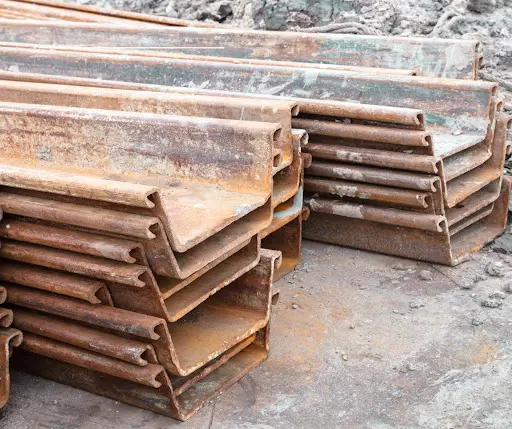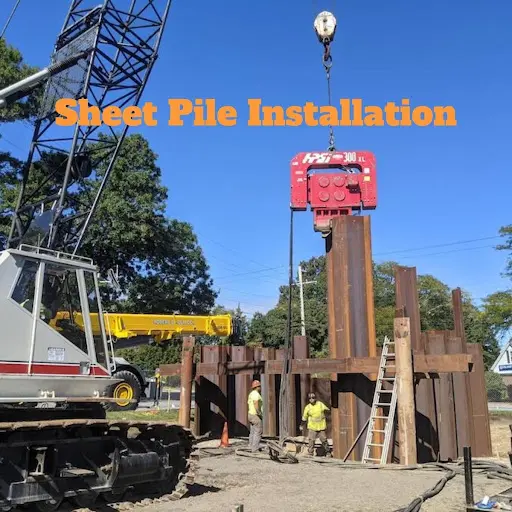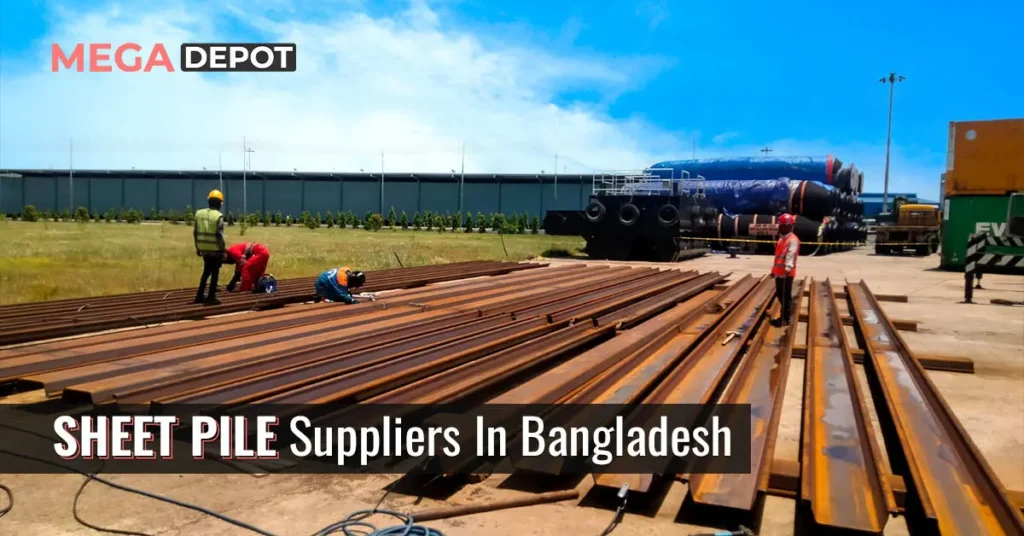Sheet pile is a prevalent type of construction material. A sheet pile is a section of sheet material with interlocking edges that is driven into the ground in order to maintain the earth’s stabilization and support excavations. Several types of sheet piles include steel, wood, and reinforced concrete.
Sheet pile walls are flexible vertical walls made up of continuously interlocked piles.
Today we are going to share sheet pile details along with everything about sheet pile suppliers in Bangladesh.
What Is Sheet Pile

As a general rule, steel sheet piles are used in construction. It consists of a hot-rolled steel sheet section interlocked with other similar sheets by clutches. These sections of strong and resilient sheet piles form a wall when driven into the ground and connected together.
A steel sheet pile securely retains earth, water, or seawater on one side, while safeguarding a physical asset, such as property, infrastructure, or people.
Depending on their purpose, they can be used for permanent or temporary lateral earth or water retention, with the installed sheet piles removed after service. Construction projects use steel sheet piles to support excavations efficiently and effectively. It is, therefore, worthwhile to buy steel sheet piles.
Purpose Of Sheet Piles
Sheet pile provides lateral support and resists lateral pressure such as that caused by loose soil and water flow.
The following are some purposes of sheet piles:
- Maintaining soil retention around the trenches for the foundation.
- Build a retaining wall.
- Building erosion protection structures.
- Separating the foundation from the surrounding soils by containing the soil.
Advantages Of Sheet Piling
- A sheet pile is a recyclable and reusable material.
- Steel piles come in a variety of lengths, sizes, and shapes.
- These structures can be used both temporarily and permanently.
- It is possible to install them silently and vibration-free.
- No spoils arise from work, which is neat and clean. This reduces the supervision of work on-site and reduces the storage space requirements.
- Sheet piling is more cost-effective and faster than adjacent or secant walls.
- It is possible to construct cofferdams in almost any shape. However, due to practical and economic considerations, most cofferdams are rectangular or circular.
- Using sheet piles can provide a tight-fitting joint to seal water effectively.
- The long life of these pipes makes them an excellent choice for marine and coastal projects.
- It is also possible to install sheet piled walls with anchors, which can provide even more flexibility.
Uses Of Sheet Piles
- Temporary sheet pile walls are used when construction occurs in confined spaces to prevent cave-ins, protecting areas nearby from injury.
- It is common to use sheet pilings as permanent walls in a home, as they provide stability and durability to interior walls (especially basement walls).
- Additionally, piling is used to prevent flooding of structures near shorelines.
- To prevent water damage to foundations.
- Providing support for excavations for parking structures, basements, foundations, pump houses, cofferdams, seawalls, and bulkheads.
Different Types Of Sheet Piles
There are many types of sheet piles depending on the material used in manufacturing them. The following are some of them:
Steel Sheet Pile
It comes in different shapes and cross-sections. There are three types of steel pipe sheet pile: hot rolled sheet piles, cold rolled, and cold formed sheet piles. The durability of steel sheet piles is enhanced by corrosion protection measures such as coatings and cathodic protection.
Sheet piles are most commonly made from steel, as it is highly resistant to high driving stresses, water-tight, and can be increased in length by welding or bolting. Interlocking holds them together.
The four basic types of steel sheet piles are Normal sections, Straight web sections, Box sections, and Composite sections.
Vinyl Sheet Pile
The use of vinyl sheet piling for bulkheads, seawalls, and cutoff walls is an effective alternative to steel sheet piling. Furthermore, they are superior to alternatives such as concrete and wood. Vinyl sheet piles offer superior corrosion resistance when exposed to seawater, where oxidation is not present.
Wooden Sheet Pile
Wooden sheet piles are commonly used in temporary structures and excavations for braced sheeting. It must be treated with some form of preservative if used in permanent structures above the water table.
Wooden sheet piles have a short life span, even when they are treated with preservatives. Using tongue and groove joints, timber sheet piles are joined together. The use of timber piles is not feasible in strata consisting of gravel and boulders.
Concrete Sheet Pile
It is common for concrete sheet piles to be connected with tongues and grooves. The structures are commonly used in permanent river embankments, canals, and other marine structures.
Usually, the pile heads are finished off by casting a capping beam, while the toes are cut with an oblique face for easy driving and interlocking. It is usually tongue and groove joints that connect these precast concrete members. As a result of their bulk and weight, they displace large amounts of soil during the driving process.
In addition, due to the large volume displacement, the driving resistance is increased. Therefore, it is important to ensure that the piles are not damaged during handling and driving and that adequate reinforcement is utilized.
Sheet Pile Installation Methods

Choosing the sheet piling installation method is determined by the site conditions at the construction site as well as an in-depth soil investigation. Several methods can be used to install steel sheet piles in the ground.
Among the most important parameters to consider are soil conditions, sheet pile section and length, driving equipment, permanent vs. temporary wall, visible wall (coatings for aesthetics), installation tolerances (vertical, position), and interlock sealing systems.
Vibratory hammers, impact hammers, presses, or a combination of these driving devices are commonly used in standard installation techniques. The first few meters of long sheet piles might be driven faster and more efficiently with a vibratory hammer or pressing machine, followed by impact hammers for the last meters.
Three key sheet piling methods are typically used in sheet pile installation:
- Panel Driving
- Panel Driving with Staggering of Sheet Piles
- Pitch and Drive
Panel Driving
Using this method, a panel is erected inside a stiff template (preferably two levels) before the sheet piles are driven. Each element of the panel is usually driven a few meters into the ground in a specific order. The recommendation is to
- In the case of permanent walls (like underground parking garages, and basements),
- If installation tolerances are quite important (e.g. interlocks with a sealing system),
- When soils are predicted to lean (for example, very soft soils)
Main advantage: It is easier to achieve the required tolerances and prevent leaning in sheet piles.
Main disadvantage: The process takes longer (handling & threading the piles) and requires a longer crane boom (lifting the piles).
Panel Driving With Staggering Of Sheet Piles
Similar to panel driving, this method uses alternate piles that are reinforced with a tip and staggered so that these reinforced sheet piles are driven deeper than non-reinforced piles.
It is useful when soil conditions are compact to drive sheet piles like this.
Pitch and Drive
This method of piling construction is popular because it is relatively quick and inexpensive. Typically, sheet piles are threaded and installed using a hammer, usually, in areas where leaning won’t be an issue, soils aren’t too compacted, and where the installation is temporary.
The pitch and drive method of installing sheet piles usually results in short piles. Using hydraulic presses is the only method that can be used for the construction of one-sheet piles. Giken silent pressing rigs can overcome noise issues associated with pitch and drive sheet pile installations.
Best Sheet Pile Supplier In Bangladesh
The use of sheet piles is essential in construction. As a result, sheet piles are almost always required on construction sites. There are many companies in Bangladesh that supply sheet piles. Among them, Mega Depot & SIMEX Bangladesh is the best sheet pile suppliers in Bangladesh.
Among the best sheet pile suppliers in Bangladesh, they are renowned for the quality and service they provide. The company’s products are used in a wide range of applications for a wide range of projects. Whenever it comes to reliability and quality, all of their products and sheet piling services meet international standards.
Why Choose Mega Depot For Buying Or Renting Sheet Pile?
Mega Depot is Bangladesh’s foremost sheet pile supplier and provides sheet pile rental services. Sheet piles are one of the construction materials we supply. Steel is the main material we use for making sheet piles because it is durable and high-quality. We have a team of professional engineers and contractors who will help customers choose the right types of sheet piles for their projects. Our company delivered sheet piles to all parts of the country.
We have a fleet of modern, safe machines available to install sheet piles in all locations at Mega Depot. To satisfy the needs of our customers, we supply fresh and new sheet piles. Mega Depot is regarded as a trustworthy partner by our customers due to its ability to deliver accurate sheet pilling.
Final Verdict
Now that you know more about sheet pile suppliers in Bangladesh, you have a clear picture of them. Global construction projects, especially large infrastructures, are becoming increasingly complex, thus requiring advanced construction methods and materials. It is no different with sheet piles.
Around the world, Mega Depot’s sheet piles have proven their durability. Mega Depot is a global supplier of Sheet Piles for sale due to these factors and a strong commitment to delivery timelines. These structures include port and harbor structures, river revetments, retaining walls, cutoff walls, slope protection, and cofferdams.
